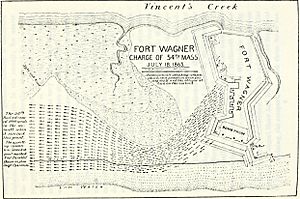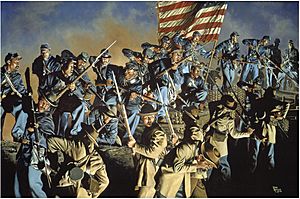Second Battle of Fort Wagner facts for kids
Quick facts for kids Second Battle of Fort Wagner(Second Assault on Morris Island) |
|||||||
|---|---|---|---|---|---|---|---|
| Part of the American Civil War | |||||||
 54th Massachusetts Regiment charging towards Fort Wagner |
|||||||
|
|||||||
| Belligerents | |||||||
| Commanders and leaders | |||||||
| Quincy A. Gillmore Truman Seymour John A. Dahlgren Robert Gould Shaw † George C. Strong † |
P.G.T. Beauregard William B. Taliaferro Johnson Hagood |
||||||
| Units involved | |||||||
| See Union Order of Battle | See Confederate Order of Battle | ||||||
| Strength | |||||||
| 5,000 troops 6 Ironclads |
1,800 troops | ||||||
| Casualties and losses | |||||||
| 1,515 total (246 killed; 880 wounded; 389 missing/captured) |
174 total (36 killed; 133 wounded; 5 missing/captured) |
||||||
The Second Battle of Fort Wagner was a major fight during the American Civil War. It happened on July 18, 1863. Union Army troops, led by General Quincy Gillmore, tried to capture Fort Wagner. This fort was a strong Confederate base on Morris Island, protecting Charleston Harbor.
The Union attack was not successful. However, the brave actions of the Black Union soldiers in this battle were highly praised. This encouraged more African-Americans to join the Union army. It helped the Union gain more soldiers, a resource the Confederacy mostly avoided using during the war.
Contents
What Was Fort Wagner?
Fort Wagner, also known as Battery Wagner by the Confederates, was a key defense. It guarded the southern entrance to Charleston Harbor. General William B. Taliaferro was in charge of the fort.
A week before, on July 11, the Union had tried to attack the fort. This was called the First Battle of Fort Wagner. That attack failed, with many Union soldiers lost due to heavy cannon and rifle fire.
Why Was Fort Wagner So Strong?
Fort Wagner was built on a very narrow island. This meant the Union army could only attack it with a few soldiers at a time. The path to the fort was a strip of beach only about 60 yards (55 meters) wide. The ocean was on one side, and a marsh was on the other.
The fort itself was about 250 yards wide on its southern side. It had a shallow moat around it. This moat was filled with sharp palmetto logs. The part of the moat facing the sea even had spiked planks hidden underwater.
Fort Wagner's Defenses
On the night of the battle, Fort Wagner had many cannons. These included mortars, carronades, and howitzers. Some guns were placed outside the fort to fire sideways at attackers. The fort's walls were made of sand, which absorbed cannon fire well. The defenders could hide in a special bombproof shelter during bombardments.
The Battle Begins
General Gillmore ordered his cannons and mortars to start firing on Fort Wagner on July 18. Six Union warships, called monitors, also joined in. They moved very close to the fort, about 300 yards away.
The bombardment lasted for eight hours. But it did little damage to the fort's sandy walls. Most of the Confederate soldiers were safe in their bombproof shelter. Only about 8 men were killed and 20 wounded during this long shelling.
The Union Attack: Who Led the Charge?
The 54th Massachusetts, a brave group of African-American soldiers, led the Union attack. Their leader was Colonel Robert Gould Shaw. They began their charge at dusk.
Behind them were two more groups of soldiers, made up of nine regiments. The first group was led by General George Crockett Strong. It included the 54th Massachusetts and other regiments like the 6th Connecticut and 48th New York. The second group was led by Colonel Haldimand S. Putnam. A third group was kept in reserve but did not join the fight.
The Fierce Fight at the Fort
The attack started at 7:45 p.m. The 54th Massachusetts attacked the western part of the fort. Other Union soldiers attacked the southern side. As the Union soldiers got closer, the Confederate defenders opened fire with cannons and rifles. They caused many losses among the attacking troops.
The 54th Massachusetts bravely reached the fort's wall, called the parapet. They fought hand-to-hand with the Confederates. But they were forced back. The 6th Connecticut continued the attack at a weaker spot in the fort's defenses. Other Union regiments also reached the fort's slopes.
The Confederates fought back hard. They fired cannons that shot many small balls, like giant shotguns, into the Union soldiers. They even tried to counter-attack twice. As the Union attack weakened, more Confederate soldiers arrived to help defend the fort. These fresh troops pushed back the remaining Union soldiers.
By 10 p.m., the intense fighting was over. Many soldiers on both sides were lost. Several Union leaders were killed or badly wounded, including Colonel Shaw of the 54th Massachusetts. Sergeant Major Lewis Henry Douglass, whose father was the famous speaker Frederick Douglass, survived the battle and wrote about it.
What Happened After the Battle?
About 1,515 Union soldiers were killed, captured, or wounded in this battle. The Confederate commander, General Hagood, reported burying 800 Union bodies in mass graves. The 54th Massachusetts lost many men; only 315 were left after the battle. Colonel Shaw was killed and buried with his men.
Heroes of Fort Wagner
The soldiers of the 54th Massachusetts were praised for their courage. William Carney, an African-American sergeant with the 54th, became famous for his bravery. He saved the unit's U.S. Flag during the battle and brought it back to Union lines. He was the first black soldier to receive the Medal of Honor for his actions that day.
Their brave actions showed everyone that African Americans could be excellent soldiers. This led to more African-Americans joining the Union army, which gave the North a big advantage in numbers. Also, for the first time, the South began to treat captured African-American soldiers as regular enemy soldiers, not criminals.
The Confederates had fewer losses, with about 174 casualties. They continued to hold Fort Wagner. However, they abandoned the fort on September 7, 1863. This was after 60 days of constant shelling. The fort was too damaged to hold, and Union trenches were getting too close.
Saving the Battlefield
In 2008, a group called the Trust for Public Land (TPL) and its partners bought Morris Island. They paid $3 million to save the island from being developed with houses. Before this, in 2003, there were plans to build on the land. But preservation groups worked hard to stop it.
Now, the city and county are working to protect the island's important historical and natural sites. This helps make sure that the history of Fort Wagner and the brave soldiers who fought there will not be forgotten.
In Popular Culture
- The battle is shown in the 1989 movie Glory. This movie tells the story of the 54th Massachusetts Regiment.
- An early short story by Louisa May Alcott, "My Contraband" (1863), describes what happened after the battle. It features a Union Army nurse caring for wounded soldiers from the 54th Regiment.




